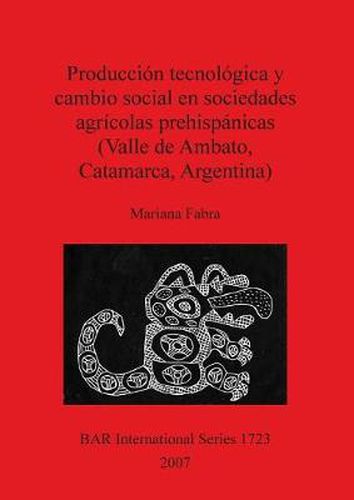Readings Newsletter
Become a Readings Member to make your shopping experience even easier.
Sign in or sign up for free!
You’re not far away from qualifying for FREE standard shipping within Australia
You’ve qualified for FREE standard shipping within Australia
The cart is loading…






This title is printed to order. This book may have been self-published. If so, we cannot guarantee the quality of the content. In the main most books will have gone through the editing process however some may not. We therefore suggest that you be aware of this before ordering this book. If in doubt check either the author or publisher’s details as we are unable to accept any returns unless they are faulty. Please contact us if you have any questions.
This volume is concerned with craft specialization and cultural complexity in prehispanic Andean communities in northwestern Argentina, with particular reference to cultural and social processes in the Ambato Valley (Provincia de Catamarca, Argentina) in the first millennium. The analytical perspective is based on technological processes and labour investment applied to the manufacture of different ceramic wares. The objectives of this study are not only to contribute to the study of social change through the analysis of the technological processes of pottery production, but also to analyze and compare production at two different cultural moments, studying its variability through time, production, distribution, use and discard contexts involved in pottery production. The author begins with an introduction to general and particular objectives, hypothesis and theoretical background to craft production and cultural complexity, social change and craft specialization. Chapter 2 contextualizes chronologically and culturally case studies related to Condorhuasi, Cienaga and Aguada. Chapters 3 and 4 present the archaeological sites and the results obtained in relation to the pottery technology. Chapter 5 centres on specific analysis of labour investment, as one of the theoretical approaches to the study craft specialization. In the final chapter, the author presents her conclusions, linking both craft specialization and social change. Overall, the work is an important contribution to the knowledge of past Andean communities, as well as an original insight into craft specialization and labor-technology change.
$9.00 standard shipping within Australia
FREE standard shipping within Australia for orders over $100.00
Express & International shipping calculated at checkout
This title is printed to order. This book may have been self-published. If so, we cannot guarantee the quality of the content. In the main most books will have gone through the editing process however some may not. We therefore suggest that you be aware of this before ordering this book. If in doubt check either the author or publisher’s details as we are unable to accept any returns unless they are faulty. Please contact us if you have any questions.
This volume is concerned with craft specialization and cultural complexity in prehispanic Andean communities in northwestern Argentina, with particular reference to cultural and social processes in the Ambato Valley (Provincia de Catamarca, Argentina) in the first millennium. The analytical perspective is based on technological processes and labour investment applied to the manufacture of different ceramic wares. The objectives of this study are not only to contribute to the study of social change through the analysis of the technological processes of pottery production, but also to analyze and compare production at two different cultural moments, studying its variability through time, production, distribution, use and discard contexts involved in pottery production. The author begins with an introduction to general and particular objectives, hypothesis and theoretical background to craft production and cultural complexity, social change and craft specialization. Chapter 2 contextualizes chronologically and culturally case studies related to Condorhuasi, Cienaga and Aguada. Chapters 3 and 4 present the archaeological sites and the results obtained in relation to the pottery technology. Chapter 5 centres on specific analysis of labour investment, as one of the theoretical approaches to the study craft specialization. In the final chapter, the author presents her conclusions, linking both craft specialization and social change. Overall, the work is an important contribution to the knowledge of past Andean communities, as well as an original insight into craft specialization and labor-technology change.